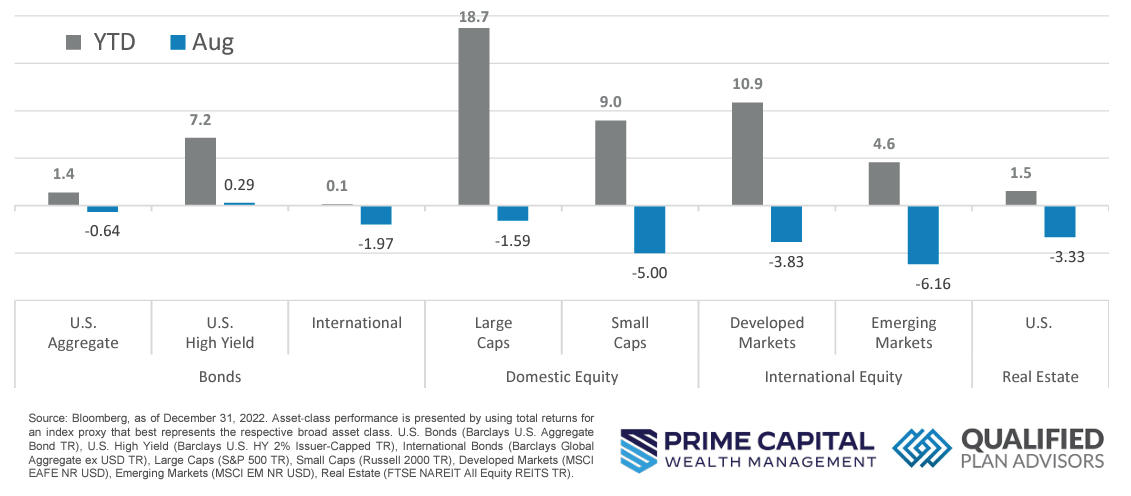Quick Takes
- Risk Assets Hit Summer Fatigue. Risk assets closed out the summer in the red for the month on the back end of some disappointing earnings results.
- Inflation Rises Modestly. Inflation, as measured by the Fed’s preferred data point of Core PCE Deflator, had a modest tick up for the August reading, but most market participants shrugged this off as a temporary spending boom on end of summer vacations, or similar entertainment events, as well as parents preparing for children returning to school in the coming weeks.
- Dollar Summer Strength. The greenback bucked the weakness it has displayed most of the year and had a modestly strong month to close out the summer, appreciating against most major currencies as some international economies had some signs of weakness.
- Economic Production Revised Lower, Labor Markets Stay Tight. The first revision to GDP for the second quarter of the year was revised modestly lower, catching some market participants off guard. Labor Markets, as measured by the Unemployment Rate, came in lower than estimates of 3.6%, landing at 3.5% for the month of July.
Asset Class Performance
Risk Assets lost some steam in the final month of the summer as earnings season began winding down and some signs of weakness in the global economic system became apparent. While August wasn’t a strong month for risk assets, year-to-date returns are still healthily in the green.
Markets & Macroeconomics
With all the drama surrounding interest rates this year, it should come as no surprise that mortgage rates have skyrocketed during the Fed’s tightening campaign in their battle against high inflation levels. Towards the end of August, average 30-year fixed rates for mortgages hit its highest level in over two decades at 7.31%. With mortgage rates at this level, homeowners have been reluctant to list their homes on the market, leading to a steep decline in inventory. With inventory being low, Existing Home Sales at the end of summer were close to levels at the start of the year. There was a modest bump in home sales in Spring surrounding the regional banking crisis started by the collapse of Silicon Valley Bank and the subsequent drop in interest rates as market participants feared that the effects would reverberate across financial markets. While activity in the housing market has been declining, prices have modestly bumped up as the summer winds down. With prices increasing and inventory of existing home sales remaining depressed, the housing market is very unfavorable for potential home buyers and when considering the added burden of sky-high mortgage rates, the situation becomes even more abysmal for home buyers. While the situation for Existing Home Sales appears dire, home builders have benefited from the lack of existing supply, as evidenced by the sharp increase in the August reading of New Home Sales coming in at an annualized rate of +4.4%, the highest level in over 12-months. Additionally, with the low supply of existing homes and new homes filling some of the demand, prices have increased with the median new home price coming in at $437,700, which was up substantially from the prior reading of $416,700. With existing home prices bumping up and new home prices rising right along with them combined with elevated interest rates on mortgages, home buyers are in a tough spot even with inflation showing some recent signs of moderating over the past several months.
Bottom Line: With inflation showing signs of moderating in recent months, many consumers are hopeful that some of the pressure on their wallets will begin to ease. Home buyers haven’t seen that moderation in prices though, with existing home inventories remaining at depressed levels, leading to moderately increasing prices for existing homes that do have a for sale sign in the yard. Additionally, home builders are benefitting from the lack of existing supply with new homes commanding a hefty median price of $436,700 in the August reading of New Home Sales. Further to the detriment of home searchers, the average fixed rate for mortgages hit a fresh high of 7.31% at the end of August.
©2023 Prime Capital Investment Advisors, LLC. The views and information contained herein are (1) for informational purposes only, (2) are not to be taken as a recommendation to buy or sell any investment, and (3) should not be construed or acted upon as individualized investment advice. The information contained herein was obtained from sources we believe to be reliable but is not guaranteed as to its accuracy or completeness. Investing involves risk. Investors should be prepared to bear loss, including total loss of principal. Diversification does not guarantee investment returns and does not eliminate the risk of loss. Past performance is no guarantee of comparable future results.
Source: Bloomberg. Asset‐class performance is presented by using market returns from an exchange‐traded fund (ETF) proxy that best represents its respective broad asset class. Returns shown are net of fund fees for and do not necessarily represent performance of specific mutual funds and/or exchange-traded funds recommended by the Prime Capital Investment Advisors. The performance of those funds June be substantially different than the performance of the broad asset classes and to proxy ETFs represented here. U.S. Bonds (iShares Core U.S. Aggregate Bond ETF); High‐Yield Bond (iShares iBoxx $ High Yield Corporate Bond ETF); Intl Bonds (SPDR® Bloomberg Barclays International Corporate Bond ETF); Large Growth (iShares Russell 1000 Growth ETF); Large Value (iShares Russell 1000 Value ETF); Mid Growth (iShares Russell Mid-Cap Growth ETF); Mid Value (iShares Russell Mid-Cap Value ETF); Small Growth (iShares Russell 2000 Growth ETF); Small Value (iShares Russell 2000 Value ETF); Intl Equity (iShares MSCI EAFE ETF); Emg Markets (iShares MSCI Emerging Markets ETF); and Real Estate (iShares U.S. Real Estate ETF). The return displayed as “Allocation” is a weighted average of the ETF proxies shown as represented by: 30% U.S. Bonds, 5% International Bonds, 5% High Yield Bonds, 10% Large Growth, 10% Large Value, 4% Mid Growth, 4% Mid Value, 2% Small Growth, 2% Small Value, 18% International Stock, 7% Emerging Markets, 3% Real Estate.
Advisory products and services offered by Investment Adviser Representatives through Prime Capital Investment Advisors, LLC (“PCIA”), a federally registered investment adviser. PCIA: 6201 College Blvd., Suite#150, Overland Park, KS 66211. PCIA doing business as Prime Capital Wealth Management (“PCWM”) and Qualified Plan Advisors (“QPA”). Securities offered by Registered Representatives through Private Client Services, Member FINRA/SIPC. PCIA and Private Client Services are separate entities and are not affiliated.
© 2023 Prime Capital Investment Advisors, 6201 College Blvd., Suite #150, Overland Park, KS 66211.


